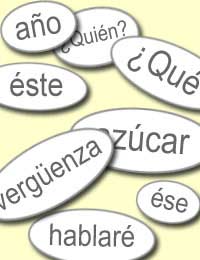Accents in Spanish

The main accent used in the Spanish language is the acute: this is how it looks, for example, over an a: á. There are no grave accents – i.e. accents which point the other way – as there are in French.
Note that it is used only to indicate stress over a vowel – it doesn’t affect how the letter actually sounds.
By stress, we mean the stronger emphasis that falls on one particular syllable of any word which has two or more syllables. (There are similar stress patterns in English.)
There are three rules about the positions of stress on any Spanish word.
The first is that if a word ends in either a vowel, or an ‘n’ or an‘s’, the next to last syllable is stressed. Take a look at these examples:
cosa (thing)
habla (speak)
agua (water)
The second rule is that if a word ends in a consonant other than ‘n’ or ‘s’, the stress falls instead on the final syllable. Here are some examples:
arroz (rice)
comer (the verb to eat)
The third rule is that if a word doesn’t conform to either of these two rules, it will take an accent to show where the stress falls. So:
azúcar (sugar)
hablaré (I will talk)
Plurals
Some groups of words have an accent in the singular but not in the plural form – and vice versa.Examples include words ending in –an, -én, -ín, -ón, -ún, -és:
So estación (station) becomes estaciones, ingles (English) becomes ingleses, rehén, the word for hostage, becomes rehenes, and so on.
The same rule applies to words ending in –en where the stress falls on the penultimate syllable.
So examen (exam) becomes exámenes, and origen (origin) becomes orígenes.
Interrogatives
In all interrogative or questioning words, the stress accent is used on the stressed syllable, as shown below:¿Qué? What?
¿Quién? Who?
Demonstrative Adjectives
An accent also falls on the pronoun forms of demonstrative adjectives, like so:éste y ése mean ‘this one’ and ‘that one’ respectively.
Distinguishing Words
An accent is also used to distinguish two words which would otherwise have identical spelling. So:
de means ‘of’ or ‘from’, while dé is a command form of the verb dar, to give el is the masculine ‘the’, but él means ‘he’ or ‘him’ mi means ‘my’ but mí is the word for ‘me’si means ‘if’ but sí means ‘yes’ te means ‘you’ but té is the word for tea tu means ‘your’ but tú means ‘you’
The Diaresis
This looks like this: ü. It is like the German umlaut, and used only in these combinations of letters: -güe and –güi to show that the ‘u’ is sounded.A good example, is the word for shame, or disgrace – la vergüenza.
The ñ in Spanish
The squiggle over some ‘n’s in Spanish is known as the tilde. It is one of the few ways the Spanish alphabet differs from the Latin one, and is unique to this language.
Historically, it came about when scribes transcribing Latin used the tilde to donate that a word had two ‘n’s, with the squiggle donating the second. This is, for example, how the Latin annus became the Spanish año (the word for year.)
The ñ is considered a letter in its own right in Spanish, and you will find it classed as such in dictionaries.
Its sound is like the ‘nye’ sound in the middle of ‘onion’.
- How to Learn Future Tense in Spanish
- Spanish Words to Watch Out For
- The Subjunctive in Spanish
- Irregular Verbs in Spanish
- The Past Imperfect Tense in Spanish
- The Conditional Tense in Spanish
- The Past Preterite Tense in Spanish
- Personal Pronouns in Spanish
- The Infinitive in Spanish
- Ser and Estar in Spanish
- The Present Tense in Spanish
- Por and para in Spanish
- Personal a in Spanish
- Adjectives in Spanish
- Gender of Nouns in Spanish


Re: Spanish Phrases for Hotels
Hi, I work in a hotel in the US. I'm trying to learn phrases in Spanish to speak to my Spanish speaking guests. Phrases…
Re: Spanish Numbers Days and Months
How do you say the twelfth month in Spanish. Not the month itself. Just that phrase
Re: Personal Pronouns in Spanish
How come vosotros isn't in the subject pronouns?
Re: The Influence of Spanish on English
I have found this website very useful and the present article has helped me a lot in understanding the influence of…
Re: The Past Preterite Tense in Spanish
magb123 - Your Question:You have a typo on 'ser'. The first person singular is 'fui' not 'fu'Our Respo
Re: The Past Preterite Tense in Spanish
you have a typo on 'ser'. The first person singular is 'fui' not 'fu'
Re: Spanish Numbers Days and Months
I´m spanish, i could give custom classes to anyone interested.
Re: The Past Preterite Tense in Spanish
Some typos on this otherwise excellent page: "Ponder" for poder and "fu" for fui. You need a proofreader.
Re: Colours in Spanish and How They Are Used
i really found this site very helpful as a college student! thanks